
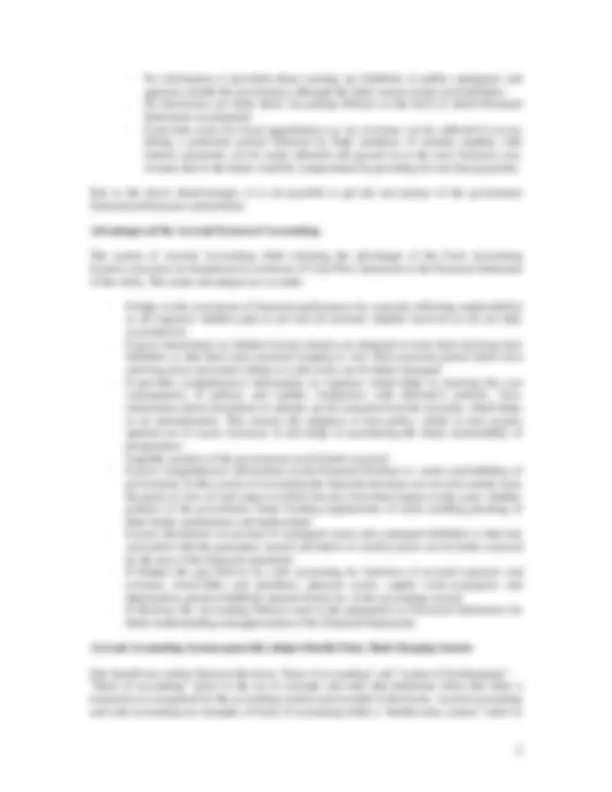
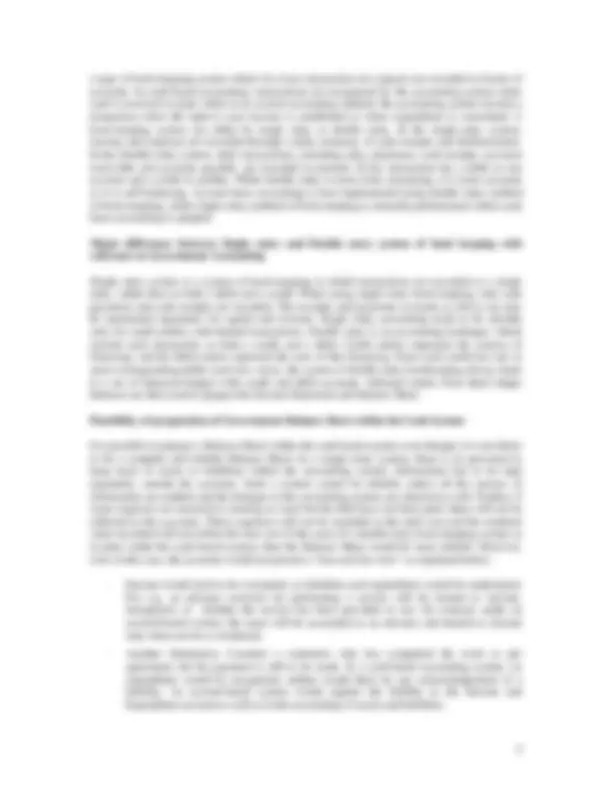
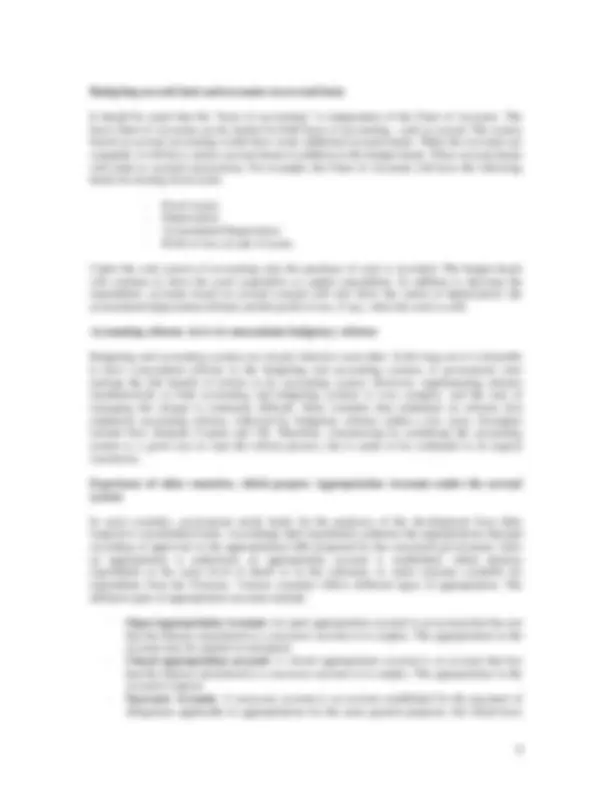
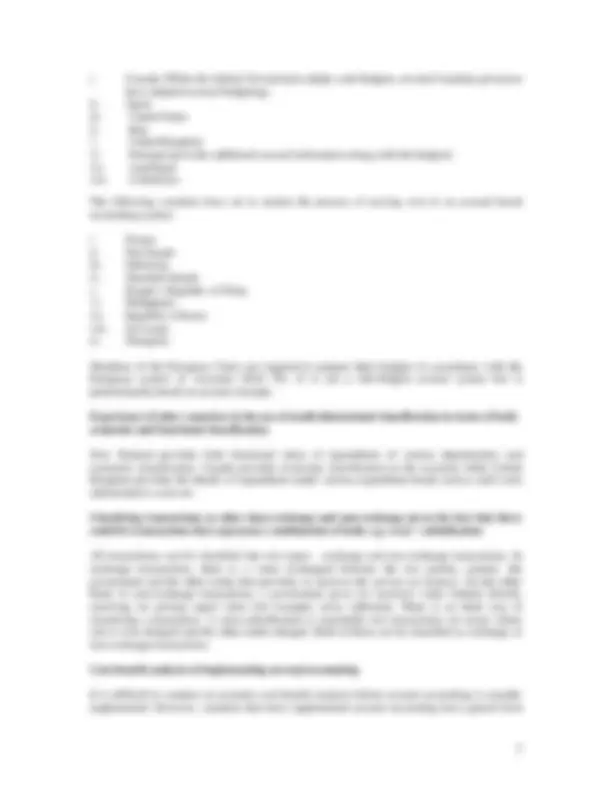
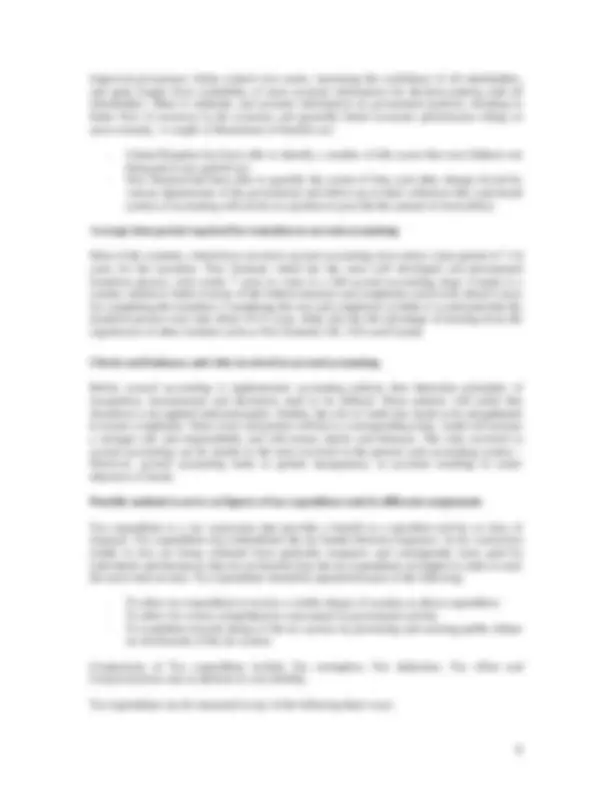
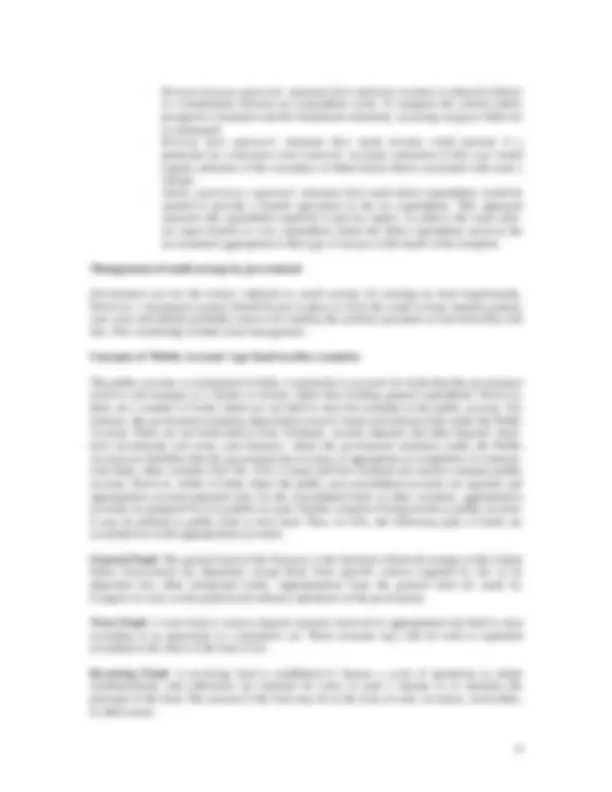
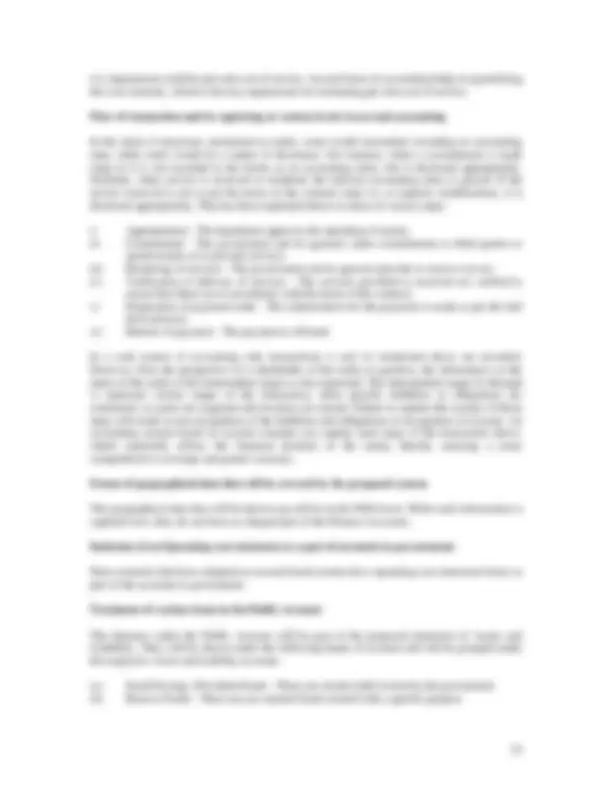
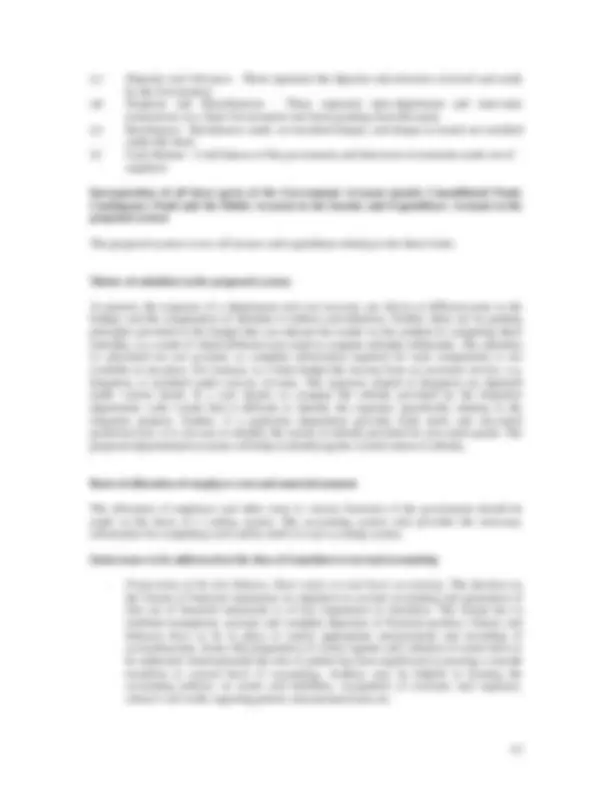



Study with the several resources on Docsity

Earn points by helping other students or get them with a premium plan


Prepare for your exams
Study with the several resources on Docsity

Earn points to download
Earn points by helping other students or get them with a premium plan
Community
Ask the community for help and clear up your study doubts
Discover the best universities in your country according to Docsity users
Free resources
Download our free guides on studying techniques, anxiety management strategies, and thesis advice from Docsity tutors
The limitations of cash-based accounting in providing a complete financial picture for governments, particularly in relation to fixed assets, current assets, government liabilities, and accrued revenues and expenses. It also highlights the benefits of accrual accounting, including improved governance, better control over assets, and more accurate information for decision-making. The document also touches upon the transition to accrual accounting, the role of accounting policies, and the importance of accurate revenue recognition.
Typology: Study Guides, Projects, Research
1 / 15

This page cannot be seen from the preview
Don't miss anything!










Accrual Accounting
It is a system of accounting in which transaction are entered in the books of accounts, when they become due. The transactions are recognised as soon as a right to receive revenue and/or an obligation to pay a liability is created. The expenses are recognised when the resources are consumed and incomes are booked when they are earned. Therefore, the focus is on the recording of flow of resources i.e. labour, goods, services and capital., the related cash flow may take place after some time (of event) or it may or may not take place in the same accounting period.
Cash Accounting
In this system of accounting transactions are recorded when there is actual flow of cash. Revenue is recognised only when it is actually received. Expenditure is recognised only on the outflow of cash. No consideration is given to the “due” fact of the transaction. This system of accounting is simple to understand and as such needs less skill on the part of the accountant. Its whole focus is on cash management. The recognition trigger is simply the flow of cash. Budgetary and legislative compliance is easier under this system.
Limitations of cash system of accounting
The limitations of cash based accounting are:
a type of book-keeping system where for every transaction two aspects are recorded in books of accounts. In cash-based accounting, transactions are recognised by the accounting system when cash is received or paid, while in an accrual accounting method, the accounting system records a transaction when the right to earn income is established or when expenditure is committed. A book-keeping system can either be single entry or double entry. In the single-entry system, income and expenses are recorded through a daily summary of cash receipts and disbursements. In the Double-entry system, daily transactions, including sales, purchases, cash receipts, accounts receivable and accounts payable, are recorded in journals. Every transaction has a debit in one account and a credit in another. While double-entry is more time-consuming, it is more accurate as it is self-balancing. Accrual basis accounting is best implemented using double entry method of book-keeping, while single entry method of book-keeping is normally predominant where cash basis accounting is adopted.
Major difference between Single entry and Double entry system of book keeping with reference to Government Accounting
Single entry system is a system of book-keeping in which transactions are recorded as a single entry, rather than as both a debit and a credit. When using single entry book-keeping, only cash payments and cash receipts are recorded. The receipts and payments accounts as above can also be maintained separately for capital and revenue. Single entry accounting tends to be suitable only for small entities with limited transactions. Double entry is an accounting technique, which records each transaction as both a credit and a debit. Credit entries represent the sources of financing, and the debit entries represent the uses of that financing. Since each credit has one or more corresponding debits (and vice versa), the system of double entry bookkeeping always leads to a set of balanced ledgers with credit and debit accounts. Selected entries from these ledger balances are then used to prepare the Income Statement and Balance Sheet.
Possibility of preparation of Government Balance Sheet within the Cash System
It is possible to prepare a Balance Sheet within the cash based system even though, it is not likely to be a complete and reliable Balance Sheet. In a single entry system, there is no provision to keep track of assets or liabilities within the accounting system. Information has to be kept separately, outside the accounts. Such a system cannot be reliable, unless all the sources of information are audited and the linkages to the accounting system are checked as well. Further, if some expenses are incurred in creating an asset but the bills have not been paid, these will not be reflected in the accounts. These expenses will not be included in the total cost and the resultant value recorded will not reflect the true cost of the asset. If a double entry book-keeping system as in place under the cash based system, then the Balance Sheet would be more reliable. However, even in this case, the accounts would not present a “true and fair view” as explained below:
Budgeting on cash basis and accounts on accrual basis
It should be noted that the “basis of accounting” is independent of the Chart of Accounts. The basic Chart of Accounts can be similar for both bases of accounting - cash or accrual. The system based on accrual accounting would have some additional account heads. When the accounts are compiled, it will have certain account heads in addition to the budget heads. These account heads will relate to accrued transactions. For example, the Chart of Accounts will have the following heads for treating fixed assets:
Under the cash system of accounting only the purchase of asset is recorded. The budget heads will continue to show the asset acquisition as capital expenditure. In addition to showing the expenditure, accounts based on accrual concept will also show the extent of depreciation, the accumulated depreciation till date and the profit or loss, if any, when the asset is sold.
Accounting reforms vis-à-vis concomitant budgetary reforms
Budgeting and accounting systems are closely linked to each other. In the long run it is desirable to have concomitant reforms in the budgeting and accounting systems, if government were seeking the full benefit of reform in its accounting system. However, implementing reforms simultaneously in both accounting and budgeting systems is very complex, and the task of managing the change is extremely difficult. Most countries that embarked on reforms first undertook accounting reforms, followed by budgetary reforms within a few years. Examples include New Zealand, Canada and UK. Therefore, commencing by modifying the accounting system is a good way to start the reform process, but it needs to be continued to its logical conclusion.
Experience of other countries, which prepare Appropriation Accounts under the accrual system
In most countries, government needs funds for the purposes of the development from their respective consolidated funds. Accordingly their legislatures authorise the appropriations through according of approvals to the appropriations bills proposed by the concerned government. Once an appropriation is authorised, an appropriation account is established, which disclose expenditure at the same level of detail as in the estimates, to make amounts available for expenditure from the Treasury. Various countries follow different types of appropriation. The different types of appropriation accounts include:
Policy of provisioning for bad debts and its impact
Accounting for bad debts and provisioning are essentially prudent policies, and do not mean surrendering the claim to receive payment. Treating a debt as bad or provisioning for it does not mean that efforts need not be undertaken to recover the debt. The policy for providing for bad debts merely denotes the fact that recovery from such a receivable may not be certain, and to present a more accurate position (of assets in this case), a possible erosion in value of the assets is recognised in the books of accounts. The act of provisioning does not and should not change the right of government over the particular claim. If this principle is understood and practiced, there should be no issue of “encouraging defaulters”.
Use of IT/computerisation at transaction level for smooth flow of information and their compilation
Computerisation at transaction level is desirable for smooth flow of information and their compilation. Initially, the Treasury and District Treasury offices need to computerised. The extent of computerisation will depend on user capabilities, extent of networks, availability of computers etc. A detailed study needs to be undertaken to ascertain the readiness of computerisation at a location before it can be recommended.
Impact of recognising expenses on accrual basis and income on more or less cash basis
Experience of other countries
The following countries have moved over to accrual accounting and accrual budgeting: i. Australia ii. New Zealand iii. The Netherlands (in the process of introducing full accrual budgeting) iv. Sweden (in the process of introducing full accrual budgeting) v. Switzerland (in the process of introducing full accrual budgeting)
The following countries have adopted full accrual accounting but follow cash based budgeting:
i. Canada (While the federal Government adopts cash budgets, several Canadian provinces have adopted accrual budgeting) ii. Japan iii. United States iv. Italy v. United Kingdom vi. Portugal (provides additional accrual information along with the budgets) vii. Azerbaijan viii. Uzbekistan
The following countries have set in motion the process of moving over to an accrual based accounting system:
i. France ii. Fiji Islands iii. Indonesia iv. Marshall Islands v. People’s Republic of China vi. Philippines vii. Republic of Korea viii. Sri Lanka ix. Mongolia
Members of the European Union are required to prepare their budgets in accordance with the European system of Accounts (ESA 95). It is not a full-fledged accrual system but is predominantly based on accrual concepts.
Experience of other countries in the use of multi-dimensional classification in terms of both economic and functional classification
New Zealand provides both functional (item of expenditure of various departments) and economic classification. Canada provides economic classification in the accounts while United Kingdom provides the details of expenditure under various expenditure heads such as staff costs administrative costs etc.
Classifying transactions as other than exchange and non-exchange given the fact that there could be transactions that represent a combination of both, e.g. cross - subsidisation
All transactions can be classified into two types - exchange and non-exchange transactions. In exchange transactions, there is a value exchanged between the two parties, namely, the government and the other entity that provides or receives the service (or money). On the other hand, in non-exchange transactions, a government gives (or receives) value without directly receiving (or giving) equal value (for example, taxes collected). There is no third way of classifying a transaction. A cross-subsidisation is essentially two transactions (or more) where one is over-charged and the other under-charged. Both of these can be classified as exchange or non-exchange transactions.
Cost-benefit analysis of implementing accrual accounting
It is difficult to conduct an accurate cost-benefit analysis before accrual accounting is actually implemented. However, countries that have implemented accrual accounting have gained from
Management of small savings by government
Government can use the money collected as small savings for meeting its fund requirements. However, a transparent system should be put in place to track the small savings maturity pattern year-wise and identify probable sources for meeting the maturity payments as and when they fall due. This would help in better fund management.
Concepts of ‘Public Account’ type fund in other countries
The public account, as maintained in India, is primarily to account for funds that the government receives and manages as a banker or trustee, rather than funding general expenditure. However, there are a number of funds which are not held in trust but included in the public account. For instance, the government maintains depreciation reserve funds and sinking funds under the Public Account. These are not funds held in trust. Similarly, security deposits and other deposits, short- term investments and some cash balances, which the government maintains under the Public Account are liabilities that the government has to repay or appropriate on completion of contracts. Like India, other countries like UK, USA, Canada and New Zealand also need to maintain public account. However, unlike in India where the public and consolidated accounts are separate and appropriation account prepared only for the consolidated fund, in other countries, appropriation accounts are prepared for even public account. Further, instead of being termed as public account, it may be defined as public fund or trust fund. Thus, in USA, the following types of funds are accounted for in the appropriation accounts:
General Fund: The general fund of the Treasury is the fund into which all receipts of the United States Government are deposited, except those from specific sources required by law to be deposited into other designated funds. Appropriations from the general fund are made by Congress to carry on the general and ordinary operations of the government.
Trust Fund: A trust fund is used to deposit amounts received or appropriated and held in trust according to an agreement or a legislative act. These amounts may only be used or expended according to the terms of the trust or act.
Revolving Fund: A revolving fund is established to finance a cycle of operations to which reimbursements and collections are returned for reuse in such a manner as to maintain the principal of the fund. The amount of the fund may be in the form of cash, inventory, receivables, or other assets.
Inclusion of defence, heritage and environmental assets as part of asset accounting New Zealand is the only country, which recognises heritage, defence and environmental assets. United Kingdom follows a policy of valuing operational heritage assets. Non operational heritage assets such as art collections, archaeological sites, monuments and ruins are not valued. However, should some non-operational assets be valued, they are valued generally at the lower of depreciated replacement cost or net realisable value. In the United States, if a collection is held in furtherance of public service and not for gain; protected, preserved, cared for, and kept unencumbered; the same is not valued.
Differences between a receipt and payment statement under the cash system and cash flow statements/ Statement of Sources and Application of Funds under the accrual system.
The cash flow statement is similar to the receipt and payment statement under the cash system in terms of aggregate income and expenditure figures.
Impetus for adopting accrual concepts differently from private sector
The private sector focuses on commercial viability whereas the government plays a developmental and social role. Therefore, the need for economic and rural development might necessitate governments to adopt accrual concepts differently from private sector. The concept of ‘true and fair’ is different in government from that of the private sector. Further the concept of net worth in government is not as important as in the private sector. The focus of accrual accounting in government is to ensure that the output and outcome of the spending are commensurate with the inputs and the long term fiscal sustainability of government is captured appropriately.
Incorporation of the information on unpaid bills, subsidies, tax expenditure, tax arrears, etc, in the proposed system
State Government: The cash income and expenses will flow to the AG’s office from the Treasury. It is proposed that every month end, the DDOs submit details of unpaid bills to the AG’s office. Similarly, the Department of Revenue will furnish details of tax expenditure and tax arrears to the AG’s office. The Department of Revenue has a statistical cell, which maintains trends in the same. Central Government departments: The DDO of the concerned department at the end of the period, say a month, apart from the approved bills also sends copies of bills raised but not yet approved/paid to the Accounts Officers. The Accounts Officers enters the details of such bills under the relevant heads, which will appear as liabilities of the concerned department. The relevant heads to take into consideration such expenditure like accounts payable, subsidies etc.
Accrual accounting as a tool for governments to take sound decisions of financial and managerial nature
By following accrual system of accounting, governments will be better positioned to assess their financial performance and financial position. Accrual system of accounting will help in preparing the position of assets and liabilities of the government, which is not possible under the current system. This would help in better fund management and evaluation of performance of various departments. Further, accrual system of accounting would help in estimating cost of services more appropriately, which could form a crucial input for managerial decision-making.
of a department could be per unit cost of service. Accrual basis of accounting helps in quantifying the cost correctly, which is the key requirement for estimating per unit cost of service.
Flow of transaction and its capturing at various levels in accrual accounting
In the chain of processes mentioned as under, some would necessitate recording an accounting entry while some would be a matter of disclosure. For instance, when a commitment is made (step ii) it is not recorded in the books as an accounting entry, but is disclosed appropriately. Similarly, when service is received or rendered, the relevant accounting entry is passed. If the service received is not as per the terms of the contract (step iv), or requires modifications, it is disclosed appropriately. This has been explained below in terms of various steps:
i) Appropriation - The legislature approves the spending of money. ii) Commitment - The government and its agencies make commitments to third parties to spend monies or to provide services. iii) Rendering of services - The government and its agencies provide or receive service. iv) Verification of delivery of services - The services provided or received are verified to ensure that these are in accordance with the terms of the contract. v) Preparation of payment order - The authorisation for the payment is made as per the laid down process. vi) Release of payment - The payment is affected.
In a cash system of accounting only transactions i) and vi) mentioned above are recorded. However, from the perspective of a stakeholder of the entity in question, the information on the status of the entity at the intermediate stages is also important. The intermediate stages ii) through v) represent various stages of the transaction, when specific liabilities or obligations are contracted, or assets are acquired and revenues are earned. Failure to capture the essence of these steps will result in non-recognition of the liabilities and obligations or recognition of revenue. An accounting system based on accrual concepts can capture each stage of the transaction above, which materially affects the financial position of the entity , thereby ensuring a more comprehensive coverage and greater accuracy.
Extent of geographical data that will be covered by the proposed system
The geographical data that will be thrown up will be at the DDO level. While such information is captured now, they do not form an integral part of the Finance Accounts.
Inclusion of an Operating cost statement as a part of accounts in governments
Most countries that have adopted an accrual based system have operating cost statement forms as part of the accounts in government.
Treatment of various items in the Public Account
The balances under the Public Account will be part of the proposed statement of Assets and Liabilities. They will be shown under the following heads of account and will be grouped under the respective Asset and Liability accounts.
(a) Small Savings, Provident Funds - These are monies held in trust by the government (b) Reserve Funds - These are ear-marked funds created with a specific purpose
(c) Deposits and Advances - These represent the deposits and advances received and made by the Government (d) Suspense and Miscellaneous - These represent inter-department and inter-state transactions (in a State Government) and items pending final allocation (e) Remittances - Remittances made, un-encashed cheque, and cheque in transit are included under this head (f) Cash Balance - Cash balance of the government and short term investments made out of surpluses
Incorporation of all three parts of the Government Account namely Consolidated Fund, Contingency Fund and the Public Account in the Income and Expenditure Account in the proposed system
The proposed system covers all income and expenditure relating to the three funds.
Matter of subsidies in the proposed system
At present, the expenses of a department and cost recovery are shown at different parts in the budget, and the computation of subsidies is tedious and laborious. Further, there are no guiding principles provided in the budget that can educate the reader on the method of computing these subsidies, as a result of which different users tend to compute subsidies differently. The subsidies so calculated are not accurate, as complete information required for such computation is not available at one place. For instance, in a State budget the income from an economic service, e.g. Irrigation, is included under non-tax revenue. The expenses related to Irrigation are depicted under various heads. If a user desires to compute the subsidy provided by the Irrigation department, (s)he would find it difficult to identify the expenses specifically relating to the irrigation projects. Further, if a particular department provides both merit and non-merit goods/services, it is not easy to identify the extent of subsidy provided for non-merit goods. The proposed departmental accounts will help in identifying the overall extent of subsidy.
Basis of allocation of employee cost and material amount
The allocation of employee and other costs to various functions of the government should be made on the basis of a costing system. The accounting system only provides the necessary information for computing costs and by itself it is not a costing system.
Some issues to be addressed at the time of transition to accrual accounting